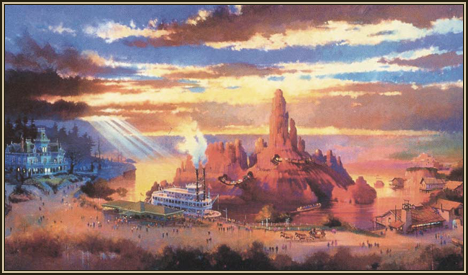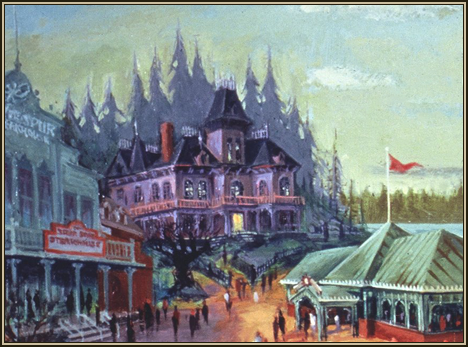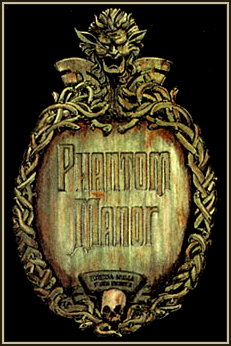
Western Spirits
Once the choice was made to construct a Disney theme park in the heart of France, the Imagineers began to face a series of challenges... Not only did the French, weary of American cultural imperialism, expect the park to reflect their own culture and sensibilities, but the number of European languages spoken by its potential clients increased the importance of non-verbal communication.
The team in charge of creating the park saw these points as more than a creative challenge. They saw it as an opportunity for this new generation of Imagineers to rethink and improve on past ideas, taking the Disneyland show to a new level. Tony Baxter was put at the head of the park’s design team and assembled a small group of executive designers. As early as 1985, this team determined which lands and attractions were going to be built in “Euro Disneyland”.

There was Eddie Sotto, who would be in charge of the Main Street USA team; Chris Tietz was going to head the creation of Adventureland; Tom Morris was going to bring Fantasyland and the park’s central icon, Sleeping Beauty Castle, to life; Tim Delaney would have the task of replacing Tomorrowland with the more timeless Discoveryland... And Jeff Burke would be put in charge of the part then known as Westernland, not least thanks to his ideas for a new incarnation of the Haunted Mansion.
It had been decided that the park would have no New Orleans Square and no Liberty Square. And unlike the Japanese, Europeans didn’t easily connect ghost houses with the fairy tales of Fantasyland. So where to put this classic attraction? It was Jeff Burke who came up with a solution, proposing a once-refined Victorian manor house in the park’s Old West section. Its ramshackle facade would tell any visitor, no matter which language they spoke, what to expect inside... thus solving two problems at the same time!
Jeff’s idea certainly convinced his colleagues: “When Tony acknowledged my interest in the lore of the Old West while discussing Phantom Manor, he asked if I would like to design Frontierland and that’s how I was put in charge of the land.”
Taking into account the Europeans’ enthusiasm for the American West in popular culture, the Imagineers expanded Frontierland and turned it into an energetic tribute to the history of the West. Calm Tom Sawyer Island, which lies in the center of Frontierland in the other parks, was replaced by the run-away mine trains of Big Thunder Mountain. Most of Frontierland was going to be home to the gold rush town of “Thunder Mesa,” the name being a reference to a discarded Marc Davis attraction originally intended for Walt Disney World.
 Frontierland concept art by Tom Gilleon. © Disney. Frontierland concept art by Tom Gilleon. © Disney.
Once the list of attractions, shops and restaurants was developed, Jeff Burke and his team started creating an appropriate mythology for the land. “We set the ‘story’ of Paris Frontierland in the American Southwest of the mid to late 1800’s. Then we modified each attraction to support this setting and time frame. For example, Big Thunder Mountain, which visually anchors the land with the look of Monument Valley, also represents the excitement and spectacle of the Gold Rush Era.”
The Haunted Mansion, it was determined, would be the home of the gold mine’s owner, who had fallen on hard times and whose stately manor-house faded along with his fortunes. Over the course of Frontierland’s development, Jeff Burke and his team created an elaborate back-story that connected the single attractions, shops, restaurants and area development with the land’s main storyline of Thunder Mesa’s rise and fall.
The owner of the Manor was determined to be one Arthur Ravenswood, a tribute to the man behind one of the most popular characters in the attraction: Thurl Ravenscroft, who supplied his face and voice to the lead singing bust. (At a later point, the story was somewhat simplified and the character of Arthur was merged into that of his brother, Henry.)
 Early concept art of Phantom Manor (detail) by Frank Armitage. © Disney. Early concept art of Phantom Manor (detail) by Frank Armitage. © Disney.
When designing the mansion’s Victorian architecture, the Imagineers turned right to that first sketch of a Disneyland haunted house by Harper Goff. Early concept paintings of Frontierland (like those seen above) show that the initial shape of the facade stayed very faithful to the 1951 sketch, complete with a protruding side wing.
Over time, as other influences and ideas were incorporated, this design evolved into the near-symmetrical Second Empire-style mansion we know today. Among the sources of inspiration was the Fourth Ward school-house in Virginia City, Nevada, a former mining town where the imagineers went to gather ideas for the “rich” Southern parts of Thunder Mesa.
Also to be determined was the attraction’s name. Would “The Haunted Mansion” be understood by the predominantly French audience? Should it be translated? The imagineers considered a number of options.
After much deliberation, the imagineers picked “Phantom Manor,” which was considered similar enough to the respective French words fantôme and manoir to be understood in a glance, and which even fit the attraction’s proposed atmosphere perfectly.

Marquee concept by Christian Hope. © Disney.
“‘Le Manoir des Fantômes’ was proposed, but we decided to keep everything in Thunder Mesa in English,” says Craig Fleming, the show writer in charge of naming the ride (and, in fact, most everything else in Frontierland). Alternate ideas referred to the attraction’s story: “Believe it or not, one of the proposed, and rejected, names was Ravenswood Manor.”
These however were only two of the changes motivated by the nature of the attraction’s multi-lingual audience... For example, would it make sense to have a constant narration play during the ride if it was only going to be understood by half the riders? And without the recurring “ghost host” spiel, what visual alternative could connect the individual show scenes? In the end, the Imagineers settled on a cast of characters that would be seen rather than heard throughout the ride...

|

